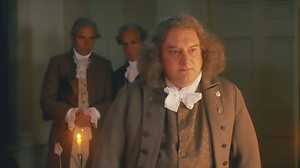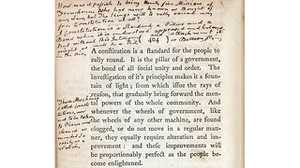The Vice Presidency of John Adams
In 1788, when John Adams returned from Europe to a hero's welcome, he came home to limitless possibilities. The presidency would belong to George Washignton, of course, but what office would suit Adams? After a month of deliberation over whether to stand for federal or state office, he decided to run for vice president. He wished to be Washington's successor.

Crushed
Under the Constitution's original election process, each elector in the Electoral College cast two ballots. The candidate with the most votes became the president; the candidate with the second most became vice president. With 69 votes, Washington was elected president unanimously. Adams came in second, but with only 34 votes. He felt humiliated and considered turning down the office. His poor showing was probably the result of future Treasury Secretary Alexander Hamilton's "backroom maneuvering" to prevent a tie and ensure a decisive victory for Washington.
His Highness, the President
Adams' primary role as vice president was as president of the Senate. He was meant to preside over proceedings -- not debate or lecture as he had in the Continental Congress. One of his most notorious missteps as vice president was inserting himself into the debate about the president's title. Adams' suggestion? "His Highness, the President of the United States of America, and Protector of the Rights of the Same." Adams believed that a title with the same pomp and grandeur of European royalty would give the presidency and the nation greater respectability on the world stage. But most senators were offended by the title's royal overtones and instead approved the title "President of the United States." For his part, Adams complained that the vice presidency "renders me so completely insignificant" that he threatened to resign. But it was an empty threat; the vice presidency was the surest route to his ultimate goal, the presidency.

Partisan Differences
Although serving as his second-in-command, Adams was by no means a close adviser to President Washington. Adams supported his domestic and foreign policies, but he never helped shape them. While the two men enjoyed a cordial relationship, the same could not be said of Adams and Thomas Jefferson, then secretary of state. As early as 1791, their friendship began to erode because of partisan differences. Both believed in Republicanism, but Adams favored a strong national government with a powerful chief executive, while Jefferson was more democratic. He championed the French Revolution, with its upheaval of French society. Adams, on the other hand, "was always for a free republic, not a democracy." The divisions between Federalists, which favored a strong federal government, and the Republicans, who favored a more decentralized government, played a significant role in the election of 1796.
Victorious
It was a four-way race, with Adams and Thomas Pinckney on the Federalist ticket and Jefferson and Aaron Burr on the Republican. The outcome was close, with Adams receiving 71 electoral votes and Jefferson 68. For once, Vice President Adams relished his role as president of the Senate when duty required him to open and read the election results proclaiming his own victory.







